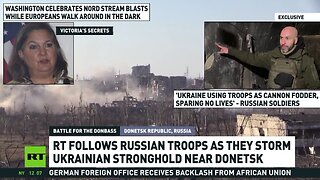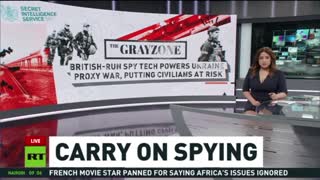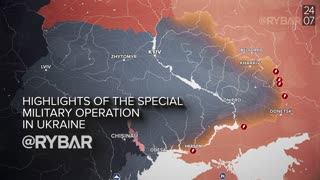RT News - January 4th 2023 Late
President Vladimir Putin sends-off a frigate armed with nuclear-capable hyper-sonic missiles on combat duty in the Atlantic and Indian oceans. (7)
Five people are killed and fifteen more wounded as Ukrainian forces strike a residential area in Russia's Zaporozhye region with civilians and emergency workers among the casualties. In Donetsk, civilian only areas once again came under attack, full casualty list unknown but at least one civilian has been injured. Civilians are now to scared to talk on camera for fear of reprisals from Ukraine forces. Report from Eva K Bartlett.
The death toll of the himars strike on New Year's day at midnight, has gone to 89 according to Russian MOD. Russia and Russians mourn their passing. Report from Murad Gazdiev.
Twitter: Washington pressured Twitter to find a Russian connection to U.S. elections even though the platform tried and failed to find any evidence. (6)
Actor Omar Sy has come under media criticism for saying that the people of France care more about the people of Ukraine than in years of French African problems. Report from Joe Mhlanga
Burkina Faso expels the French ambassador, as anti-colonial sentiment strengthens on the African continent while locals seek to cooperate with countries other than France.
RT looks back on some of the protests of 2022
======================================
1) Germany showing disrespect to Poland over World War II – Warsaw
2) Feature: Death in the air: How Moscow’s 18th century plague outbreak resembled the Covid-19 pandemic
3) --- Russian drones far cheaper than Ukrainian air defenses – NYT
4) --- Swedes adamant in face of Türkiye’s NATO demands – poll
5) --- Ex-Russian space boss sends shrapnel to French ambassador
6) --- Documents reveal how ‘Russiagate’ was used for Twitter censorship
7) --- First ship armed with Russian hypersonic missiles enters combat duty
8) --- France limits paracetamol sales
9) --- Ukraine threatens strikes ‘deeper’ into Russia
================================================
4 Jan, 2023 12:38
1) Germany showing disrespect to Poland over World War II – Warsaw
Berlin was wrong to claim the issue of reparations has been settled, a senior Polish diplomat has said
Germany’s refusal to pay World War II reparations to Poland is a sign of double standards and disrespect to the Polish people, Arkadiusz Mularczyk, secretary of state at the country’s foreign ministry, has said.
Poland is demanding $1.37 trillion from Berlin as compensation for the killings and destruction committed by Adolf Hitler’s troops during the Nazi occupation that lasted between 1939 and 1945.
The German Foreign Ministry said on Tuesday that the issue of war damages “remains closed” and Berlin does not intend to renegotiate the matter. Mularczyk blasted Germany’s position as “false.”
“The case of unsettled compensation for Poland for the effects of WWII remains open, morally, politically and legally,” Mularczyk tweeted on Wednesday. “We have an international campaign ahead of us, but I am sure that we will win for both Poland and Poles.”
Poland’s losses were unimaginable, and the Germans have received our report on the matter,” the diplomat told the Polish Press Agency on Tuesday. “Their answer, summed up in one sentence, shows an absolutely disrespectful attitude towards Poland and the Poles.”
Mularczyk accused Berlin of double standards, pointing out that the country agreed last year to pay €1.1 billion ($1.16 billion) to Namibia as compensation for colonial-era atrocities. He said Warsaw would continue to seek compensation “consistently and intensively.”
Germany maintains that its WWII-related obligations were comprehensively settled under the 1990 treaty that paved the way for the reunification of the country during the final years of the Cold War. Berlin has also argued that Warsaw waived the right to claim reparations under a 1953 deal with East Germany.
Warsaw, however, insists that Poland, which was ruled by the Communist government at the time, was pressured into signing the 1953 agreement by the Soviet Union.
Poland has made increasing calls for reparations since the conservative Law and Justice (PiS) party returned to power in 2015. The government presented a formal claim to Germany in October and said on Tuesday that it would seek the help of the UN.
https://www.rt.com/news/569379-poland-germany-wwii-reparations/
===============================================
3 Jan, 2023 12:35
2) Feature: Death in the air: How Moscow’s 18th century plague outbreak resembled the Covid-19 pandemic
Sometimes history has a way of repeating itself, and while the two situations were different, they also had many similarities
Over three years ago, in December 2019, a hospital in Wuhan, China, registered increased cases of what looked like severe pneumonia, due to an unknown cause. This turned out to be the harbinger of a reality that still reverberates with us today, having marked the beginning of the global Covid-19 pandemic, with all of the ensuing restrictions.
Yet, regardless of how new such a situation may have seemed to us, this was not humanity’s first time facing a pandemic. The notorious Black Death – the bubonic plague that became one of the defining symbols of the Middle Ages – was also fought with the help of state measures. One of the last outbreaks of this disease in Europe occurred during the reign of Russian Empress Catherine the Great. Surprisingly, many features of this bygone pandemic are reminiscent of our times and its epidemics. So, what helped Russia make it through that ordeal?
A disease from the theater of war
In 1770, Russia waged war against Turkey. This was one of the key conflicts between the empires. As a result of Saint Petersburg’s victory, huge areas of the current south of Ukraine were transferred to the Russian Empire and Crimea was acquired. However, it also brought on a major health crisis.
In the early autumn of 1769, during the fighting in Moldova and the southwestern territories of present-day Ukraine, Iasi and Khotyn, there were reports of a plague that had spread from the captured Turks. Gradually, it infected hospitals. At first, no one paid much attention to the disease. Moreover, following short local outbreaks, cases began to decline, and it seemed there was no danger in store.
However, the first incident that set off alarm bells happened in the town of Batumany. Doctor Gustav Orrues, a medic of Swedish-Finnish origin in the Russian service, was sent to the town and found it abandoned. Nearby, Orreus came across a Russian officer who reported that about 800 people out of the town’s population of 3,000 had died and the rest had fled.
The disease spread to the soldiers of the Russian garrison. An outbreak followed in Iasi. The commander, General Stofeln, who led the operations in Moldova and Wallachia, at first simply ignored the threat. By the time it became clear that the spread of the disease was out of control, Stofeln began taking measures, but it was too late: outbreaks were widespread, soldiers and townsfolk were dying, and the general himself succumbed.
Orreus organized an infirmary in a monastery near Iasi, but the genie was already out of the bottle: the disease was spreading in Moldova and whole armies were dying out. There were not a lot of medical personnel in the Russian army and almost none in the new territories. Instead of real doctors, “plague captains” were appointed in the cities to warn about the disease, organize quarantines, and distribute medicine when available. Healthy people, in the absence of other means of prevention, were given amulets.
None of that helped much. The disease spread to Transylvania, while another wave moved across Russia and Poland to the northeast. It struck Kiev and practically emptied Podol. Quarantines were initially poorly organized, and gradually the disease spread to the Don and Kuban regions through refugees and merchants.
The plague in Moscow
Early in the autumn of 1770, the virus reached Moscow. At first, most patients had a mild form of the disease. Malaria was also spreading through cities at the same time, so it went almost unnoticed until patients with pronounced buboes (swollen lymph nodes characteristic of bubonic plague) appeared. An outpost with medics was located in the city of Serpukhov near Moscow, but in November an officer who came from the army died in Lefortovskaya Sloboda. Soon the doctor who treated him died, and then more than twenty people from nearby houses also passed away. Moscow was a big city, and it was difficult to isolate it completely, particularly given that people were returning from the war, and traveling from Ukraine and from Poland. On December 21, Dr. Afanasy Shafonsky reached an unequivocal conclusion: this was the dreaded plague.
The hospital was isolated with thousands of patients and doctors inside, and the city was closed off. However, it was already too late. In fact, the key problem was the unwillingness of officials to sow panic and a persistent desire to mistake the plague for less dangerous diseases. Even the management of the hospital where the disease was recorded did not report the outbreak for a long time.
As a result, state measures were always a step behind. By the time quarantines were enacted, the epidemic had already penetrated inside a perimeter that was supposed to be protected or had escaped beyond the original place of an outbreak.
Outposts were set up at all entry points to Moscow, where merchants were inspected and quarantined. These measures seemed to help, and in February it was decided that the disease had been defeated – at one point, it was thought that it might not have been the plague at all.
But in March, a new outbreak began at a cloth factory in Zamoskvorechye. Buboes and carbuncles on the bodies of the infected left no doubt about the diagnosis. Dr. Orreus, who came from Moldova, knew well what the plague was from his work in the army. Soon, General Petr Eropkin was appointed head of the ‘headquarters’ for combating the epidemic.
The quarantine intensified. In Moscow, beggars were detained and sent to specially equipped places. Eropkin divided the city into districts, each headed by special officials who monitored separate zones. All available doctors, including retired ones, were mobilized to fight the outbreak. New cases were immediately reported to Eropkin personally, and patients were immediately isolated by the police in the hospital at the Ugresh Monastery. The houses of the sick were cordoned off and neighbors were isolated separately.
These were reasonable, decisive measures. The problem is that the Moscow administration, as well as the government as a whole, tried to lift quarantine measures as soon as possible. As a result, having nearly defeated the plague by summer, the authorities once again withdrew the restrictions.
In July, the disease struck more severely. By the end of the month, more than a hundred deaths from the plague were being recorded per day, and the number was constantly growing. By August, it was raging throughout central Russia. Those who had somewhere to go fled Moscow and spread the disease everywhere. Eropkin furiously blocked the roads, but people left on foot along country roads. In addition, due to the rapid spread of the “ulcer,” epidemic workers such as gravediggers and service personnel became in short supply. Those who remained often tried to escape. As a result, the so-called ‘mortuus’ [service personnel in plague hospitals] were forcibly assigned from among prisoners.
By the end of August, more than 7,000 people died in a month. Moscow began rebelling. People ignored the sanitary measures, believing that since the disease was spreading, such steps were pointless anyway. Moreover, attacks on doctors began.
More dangerous strains of the plague intensified in the summer. Mortality began breaking records, reaching almost 1,000 deaths per day. Mayor Pyotr Saltykov fled Moscow. And then, on September 15, 1771, catastrophe, terrible even by the standards of the time, broke out.
The plague riot
By this time, church leaders had begun making church services as ‘contactless’ as possible. Yet masses of people nevertheless gathered for collective prayers. It is clear what effect such gatherings had during the epidemic. As a result, an icon to which people flocked – and the donation box – was removed from the Varvarsky Gates of Kitay-Gorod. This had been ordered by Archbishop Ambrose, who was acting out of good intentions. However, this move caused what was already a boiling cauldron to simply explode. The crowd destroyed several private houses, demolished the Chudov monastery, and Ambrose was captured and literally beaten to death with hands and sticks. Moreover, the rioters began smashing infirmaries and releasing the sick.
Eropkin reacted harshly: On September 16, after brief and fruitless exhortations, artillery was used against the crowd. The next day, an infantry regiment arrived in Moscow and defeated the rebels. At least a hundred people were killed on Red Square.
Eropkin was not pleased with such a victory. Moreover, he was injured by a stone himself.
Grigory Orlov, a favorite of the ruler Empress Catherine II, was dispatched to Moscow carrying a large sum of money and with the authority to take any measures necessary to combat the epidemic and unrest. Five people were hanged in connection with the riot and around two hundred received various forms of punishment, from flogging to hard labor. And then the fight against the pandemic began for real.
Orlov gathered the best doctors and asked them specific questions about how to cope. Invested with the authority to act, he energetically got to work. New quarantine facilities and hospitals were built in Moscow and a separate commission was engaged to monitor the carrying out of orders. Clear detailed instructions were drawn up for doctors and officials, and stricter accounting of the dead and sick was introduced. Separately, Orlov organized assistance for those rendered poor by the epidemic, while discharged patients were given small, but tangible sums of money. This encouraged people to seek help in hospitals. The social measures were generally serious. For example, Orlov arranged public work for those who had lost their earnings and organized centralized purchases of goods from impoverished artisans – in short, he approached the problem comprehensively and systematically.
The firm and decisive policies were effective. In addition, collective immunity had begun to develop – many had already recovered, whereas those unable to fight off the disease had died. So, in the autumn, the pandemic began to subside. On November 15, Orlov triumphantly left for St. Petersburg. Although individual cases of the plague were recorded in January 1772, and even in March, the epidemic was on the decline. By April, there were no new cases in Moscow. The authorities announced a reward for handing over the belongings of those who had died of the plague, as well as unburied bodies or those buried outside cemeteries. In total, up to a thousand bodies were found this way. By autumn, the end of the crisis in Russia was announced.
The epidemic in Moscow brings a lot of sad thoughts to mind. Belated measures, the rush from a passive attitude to feverish actions, mad riots disrupting the measures aimed at containing the outbreak – all of that is surely depressing. However, it’s worth noting that both doctors and many statesmen rose to the occasion. Moscow’s fight against the plague in the 18th century demonstrated that firm, energetic leadership with professionals involved in developing a working strategy, and a combination of will and reason, are effective even under the most difficult conditions.
By Evgeny Norin, a Russian historian focused on conflicts and international politics
https://www.rt.com/russia/569010-the-plague-in-moscow/
=============================================
4 Jan, 2023 15:16
3) --- Russian drones far cheaper than Ukrainian air defenses – NYT
Such an imbalance may cost Kiev and its Western allies dearly, the paper warns
The fact that the smaller kamikaze drones used by Russia are much cheaper than the Ukrainian air defense missiles used against them is creating problems for Kiev and its Western backers, the New York Times has acknowledged.
In an article on Tuesday, the paper didn’t question Kiev’s claims that most of the UAVs launched by Russia are being shot down, but pointed out that even in this case Ukrainian air defense stocks were being exhausted.
“How long can Ukraine sustain its effort when many of its defensive measures cost far more than the drones do?” the NYT wondered.
In addition to trying to destroy the incoming drones with anti-aircraft guns and small-arms fire, Kiev’s forces have “also relied heavily on missiles fired from warplanes and the ground,” which are very expensive, it wrote.
The paper cited the head of the Ukrainian consultancy Molfar, Artem Starosiek, who claimed that using a missile against a UAV costs up to seven times more than the drone itself. The drones that Russia uses are priced at around $20,000 per unit, while a surface-to-air missile from Ukraine’s arsenal ranges from $140,000 for a Soviet-era S-300 to $500,000 for a US-supplied NASAM system, he said.
The article claims that the drones used by Russia in Ukraine are Shahed-136s, supplied by Iran. This claim has been denied by both Moscow and Tehran on many occasions. The Russian Defense Ministry insists that its Geran-2 drones are domestically made, just like all the other hardware used in the military operation against Kiev. The Iranian Foreign Ministry has only confirmed sending a small batch of drones to Russia before the outbreak of the conflict with Ukraine, stressing that no new deliveries have been made since then.
Starosiek nevertheless defended Kiev’s strategy, arguing that it still “costs far less to shoot down a drone than to repair a damaged or destroyed power station.”
However, the NYT warned that the price difference between drones and air defenses was “an imbalance that could over time favor Russia, costing Ukraine and its allies dearly, some analysts say.”
According to estimations by Molfar, Russia has targeted Ukrainian military infrastructure and energy systems with some 600 UAVs since September, when they began to be used more widely.
Russia drastically ramped up its strikes against Ukrainian infrastructure in early October in response to repeated Ukrainian sabotage on Russian soil, including the bombing of the Crimean Bridge, which Moscow blamed on Kiev. Although the attack was widely cheered by top Ukrainian officials, Kiev has denied any involvement.
https://www.rt.com/news/569386-ukraine-drones-iran-defense/
===============================================
4 Jan, 2023 13:10
4) --- Swedes adamant in face of Türkiye’s NATO demands – poll
Almost 80% oppose changing the law to fast-track joining the bloc, a DN/Ipsos survey has found
An overwhelming majority of Swedes believe their country should not betray its legal principles to meet Türkiye’s conditions for ratifying Stockholm’s NATO bid, according to a new Ipsos poll commissioned by Swedish daily Dagens Nyheter and released on Monday.
The survey found that 79% of respondents think their country should “stand up for Swedish laws” in the face of Türkiye’s demands. This red line, they said, should not be crossed even “if that delays joining NATO.”
Only 10% said that “Sweden should try to join NATO as soon as possible,” even if it entails legal compromises, while 11% said they were not sure.
The poll shows only minor discrepancies in opinion between various social groups. Men are said to be more open to compromises with Ankara than women, although they also tend to insist on protecting the country’s legal principles. As for differences along political lines, those who vote for right-wing parties are more inclined to agree to a give-and-take approach.
Despite the delays in joining NATO, the poll revealed that as many as 60% of Swedes still want to become part of the US-led military bloc, with only 19% opposing Stockholm’s membership bid.
The survey, which was conducted between December 6 and 18, is based on 1,248 interviews with Swedish voters.
In June, NATO agreed to accept Sweden and Finland to the bloc, but their membership bid has yet to be ratified by all members of the alliance, with Hungary and Türkiye’s approval still pending. Ankara has been reluctant to finalize the accession process, with President Recep Tayyip Erdogan pushing Sweden and Finland to do more to combat Kurdish “terrorism,” including extraditing people that Türkiye accuses of having terrorist links.
In early December, Sweden reportedly made some progress in this regard, handing over a man to Türkiye who had been convicted in his home country of being a member of the Kurdistan Workers’ Party. Two weeks later, however, Sweden’s Supreme Court blocked the extradition of Bulent Kenes, a former editor-in-chief of Zaman Daily who Ankara accused of being involved in an attempt to topple Erdogan in 2016.
https://www.rt.com/news/569383-sweden-oppose-t%C3%BCrkiye-nato-poll/
==============================================
4 Jan, 2023 12:33
5) --- Ex-Russian space boss sends shrapnel to French ambassador
Dmitry Rogozin is believed to have been wounded in Donetsk by a French-supplied Caesar self-propelled gun
(see also https://rumble.com/v200u20-rt-news-december-10-2022-late.html)
The former head of Russia’s space agency, Roscosmos, Dmitry Rogozin, who was injured in a Ukrainian strike in Donbass, says he has sent a piece of shrapnel removed from his body and a letter to the French ambassador in Moscow.
Rogozin was wounded in the Russian city of Donetsk on December 21, when the hotel where he was staying came under artillery attack. Russia’s Investigative Committee claims that Kiev’s forces used French-made Caesar self-propelled howitzers, which Paris supplied to Ukraine, to carry out the attack.
The former space boss said he was wounded in the right shoulder with shrapnel which landed “a millimeter” away from his spine. Local medical personnel could not extract the fragment, and Rogozin was transported to Moscow, where he underwent surgery before New Year’s.
On Wednesday, Rogozin told the media that the piece of metal removed from his body was sent to the French envoy in Moscow, Pierre Levy, along with a letter.
“You probably know how many civilians were killed in Donetsk and the frontline cities by French weapons and French mercenaries. It’s hundreds of people, including children,” the letter reads.
Rogozin, who was in Donbass leading the ‘Tsar Wolves’, a group of volunteer military advisers, said he hopes that Levy understands the extent of his personal responsibility for these deaths.
“As for the piece of shrapnel that the surgeons cut out from my spine, I ask you to pass it on to French President Emmanuel Macron. And also tell him that no one will escape responsibility for the war crimes of France, the US, UK, Germany and other NATO countries in Donbass,” he wrote.
The strike on the hotel in Donetsk killed two people, with several others wounded, including the prime minister of the Donetsk People’s Republic, Vitaly Khotsenko. Those killed were officers from the Tsar Wolves, Rogozin confirmed, adding that some members of his group were also gravely wounded.
The former space boss, who was once deputy PM and Russia’s envoy to NATO, promised to return to the frontline later this month and continue assisting those taking part in Moscow’s military operation in Ukraine.
https://www.rt.com/russia/569377-rogozin-shrapnel-france-ukraine/
=============================================
4 Jan, 2023 00:36
6) --- Documents reveal how ‘Russiagate’ was used for Twitter censorship
Democrats threatened regulation and leaked to the press to pressure the platform
Internal documents from Twitter made public on Tuesday show how the social media platform was pressured to follow the US intelligence community’s lead on censorship back in 2017. Key Democrats in the US Congress, a British university, and two media outlets – Politico and BuzzFeed – played a major role in constructing and amplifying the ‘Russiagate’ conspiracy theory, according to research by Matt Taibbi.
In a pattern established in just six weeks, from August to October 2017, Twitter went from being on nobody’s radar to agreeing to take orders from US spies as to whom to censor, Taibbi wrote on Substack.
“Threats from Congress came first, then a rush of bad headlines (inspired by leaks from congressional committees), and finally a series of moderation demands coming from the outside,” he added.
In a 30-tweet thread, Taibbi presented emails and other internal documents he obtained, thanks to Twitter’s new owner, Elon Musk.
Democrats had accused Russia of helping Donald Trump defeat Hillary Clinton in the 2016 presidential election. Their claim that Trump had ties with Moscow was based on a ‘dossier’ fabricated by a British spy. From there, they insinuated that WikiLeaks’ publishing of internal DNC documents and personal emails of Clinton’s campaign had something to do with Moscow, while ‘Russian bots and trolls’ posted ‘misinformation’ on social media, which somehow undermined the election.
By August 2017, Facebook was purging accounts accused of being “linked to Russia.” Unconcerned, Twitter sent over a list of 22 “possible” Russian accounts to the Senate Intelligence Committee, only to be denounced by Senator Mark Warner of Virginia, the ranking Democrat.
By the end of September, Twitter VP for Public Policy Colin Crowell was warning that “Warner has political incentive to keep this issue at top of the news, maintain pressure on us and [the] rest of industry to keep producing material for them.” Crowell also noted the Democrats were “taking cues from Hillary Clinton,” and that only Warner and his House counterpart, Congressman Adam Schiff, were seeking any comments from social media companies.
Meanwhile, as Taibbi put it, “a torrent of stories sourced to the [committee] poured into the news,” while several senators – including Warner but also John McCain, an anti-Trump Arizona Republican – proposed bills that would have cracked down on social media.
A “Russia Task Force” set up by Twitter on October 2 found “no evidence of a coordinated approach” by October 13. The final report on October 23 found “32 suspicious accounts and only 17 of those are connected with Russia.” Of those, only two spent anything close to $10,000 on advertising – and one of them was RT.
Policy Director Carlos Monje admits in an October 18 memo that “our ads policy and product changes are an effort to anticipate congressional oversight.” One of these changes was the October 26 ban on advertising by RT and Sputnik.
A November 22 internal email accuses the Senate Intelligence Committee of leaking Twitter’s internal report to the media. A Politico story accusing Twitter of deleting files is followed by a BuzzFeed article alleging a German-language bot network with “signs of being connected to Russia.” The committee demanded a report based on the story, which Twitter’s Yoel Roth dutifully wrote up.
“You can see how the Russian cyber-threat was essentially conjured into being, with political and media pressure serving as the engine inflating something Twitter believed was negligible and uncoordinated to massive dimensions,” Taibbi wrote.
All of this results in the internal instructions to ban anything “identified by the US intelligence community as a state-sponsored entity conducting cyber-operations.” It was the first step in the process that would eventually lead to the FBI and the Biden White House telling Twitter exactly who to censor.
https://www.rt.com/news/569358-twitter-russiagate-censorship-intelligence/
thread : https://twitter.com/mtaibbi/status/1610376851377061888
==========================================
4 Jan, 2023 11:06
7) --- First ship armed with Russian hypersonic missiles enters combat duty
President Vladimir Putin said the state-of-the-art weapon has no foreign analogues
The Russian navy frigate ‘Admiral Gorshkov,’ has become the first warship carrying Zircon hypersonic cruise missiles to begin routine combat service.
Russian President Vladimir Putin oversaw the ceremony on Wednesday via video link, declaring that the Zircon missile was a “unique weapon” and that “no other country has anything comparable.”
“I am sure that such a powerful armament will allow us to steadfastly defend Russia from potential foreign threats. It will help to maintain the national interests of our country,” Putin stated.
According to Defense Minister Sergey Shoigu, the frigate will conduct “a voyage in the Atlantic and Indian Oceans, as well as the Mediterranean Sea.”
“A ship fitted with Zircons is capable of carrying out high-precision and powerful strikes on the enemy at sea and on land,” Shoigu said. “The unique feature of Zircon hypersonic missiles is their guaranteed ability to bypass any existing or prospective air defense systems.”
Shoigu added that the missiles have a range of more than 1,000 kilometers (621 miles).
The frigate first joined Russia’s Northern Fleet in 2018. Onboard trials of the Zircon began in 2020 and were concluded last year.
https://www.rt.com/russia/569375-first-ship-russian-zircon-hypersonic-missiles/
===============================================
4 Jan, 2023 15:59
8) --- France limits paracetamol sales
With China using up its own supply, Paris has suspended online purchases of the painkiller for a month
France on Wednesday announced a prohibition on the online sale of paracetamol, which has been in short supply for several months. The ban, which will last until February, came after China restricted exports of the drug amid a surge in Covid-19 cases.
The decree was published in the government’s official journal. It notes that "tensions in paracetamol-based medicines have been continuing for more than six months,” particularly for paracetamol products for children. Furthermore, the decree stated that “uncertainties” around the “health situation in China” could aggravate the shortage.
As a result, paracetamol – most commonly sold in France under the brand name Doliprane – will only be available in-store until February 1.
China is currently grappling with a surge of coronavirus infections after Beijing relaxed its strict ‘zero-Covid’ policies. As of January 8, the country will no longer require patients to isolate after a positive test, and will reopen its international borders. This spike in infections has fueled a run on paracetamol in China, prompting the government to restrict its export, Le Monde reported.
While coronavirus cases in China have tailed off since the measures were first relaxed in early December, the US, EU, UK and a number of other countries have imposed testing and quarantine requirements on incoming travelers from China, citing the risk of a new wave of infections. Beijing has called these requirements “disproportionate” and “political.”
Paracetamol is not the only drug in short supply. Insulin and antibiotics such as amoxicillin are also becoming scarce both in France and around the world.
https://www.rt.com/news/569391-france-bans-paracetamol-online/
==============================================
4 Jan, 2023 08:48
9) --- Ukraine threatens strikes ‘deeper’ into Russia
Kiev’s spy chief said he was happy to see a recent attack on a Russian airbase, but stopped short of taking responsibility for it
There will be new strikes deep into Russian territory, Kirill Budanov, Ukraine’s top spy said on Tuesday. However, he neither denied nor claimed responsibility for a recent attack on a Russian military facility.
Speaking to ABC News, Budanov, who heads Kiev’s Main Intelligence Directorate, was asked whether it was Ukraine which had conducted a recent attack on a Russian airbase. “I can’t give an answer right now to this question. Only after [the] ending of this war,” he replied, adding, though, that he was “glad” to see the strike.
In recent weeks, Moscow has on numerous occasions accused Kiev of carrying out strikes on its military facilities inside Russian territory. Last week, the Russian Defense Ministry said that a Ukrainian drone attempted to target the Engels airfield in Saratov Region, which hosts strategic bombers. Air defenses shot down the drone, but its debris killed three service members, the ministry said at the time.
The top spy went on to predict that Russia was about to face additional attacks. These strikes would become “deeper and deeper,” Budanov claimed, alluding that this would also apply to Crimea.
He argued that the peninsula is “part of Ukraine.” “We can use any weapon on our territory,” he stated. Crimea overwhelmingly voted to join Russia in 2014 following a coup in Kiev.
He also thanked the US for providing support to Ukraine, asking Washington to stay the course and promising that results “would not take very long.” “Every taxpayer in the US will be able to see where every cent went,” Budanov said.
After midnight on January 1, Ukraine used US-made HIMARS multiple rocket launchers to hit a temporary housing area used by Moscow’s forces in the city of Makeyevka in Russia’s Donetsk People’s Republic. The strike killed 89 people, according to Russia’s Defense Ministry. It also claimed that the HIMARS launcher was later destroyed in a retaliatory strike.
Kiev's forces have also on numerous occasions used HIMARS systems and other Western-supplied arms to target civilian population in the Donbass area. Between June and early December, Ukraine conducted 185 HIMARS strikes on the Donetsk and Lugansk People's Republics, according to local authorities.
Ukraine has repeatedly asked the US to support it with longer-range weapons. However, Washington has so far been reluctant to meet this request over fears of escalation.
In September, Russian Foreign Ministry spokeswoman Maria Zakharova warned the US that should it provide Kiev with such weaponry, it would cross a “red line” and make America “a direct party to the conflict.”
https://www.rt.com/russia/569368-ukraine-strikes-deeper-russia/
================================================
-
 33:03
33:03
QueenStreet
1 year agoRT News - January 18th 2023 Late
3.25K1 -
 28:08
28:08
QueenStreet
1 year agoRT News - January 27th 2023 Late
6.16K5 -
 29:04
29:04
vorrumble
1 year ago2023-01-05 RT News - January 5th 2023
23 -
 24:31
24:31
No WaR
1 year agoRT News - January 12 2023 (09:00 MSK)
18 -
 31:17
31:17
No WaR
1 year agoRT News - November 17 2022 (20:00 MSK)
14 -
 6:01
6:01
SupportRussia
7 months ago❗️🇷🇺🇺🇦🎞 Rybar Daily Digest of the Special Military Operation: October 7-13, 2023
217 -
 2:15
2:15
SupportRussia
10 months ago❗️🇷🇺🇺🇦🎞 Rybar Daily Digest of the Special Military Operation: July 24, 2023
142 -
 3:32
3:32
badanov
4 months agoChNN news report for January 14th, 2024
1.16K -
 1:21:45
1:21:45
Foreign Agent Intel
1 year ago $0.04 earnedNews Round Up, August 4th - Inside Russia Report
184 -
 31:12
31:12
No WaR
1 year agoRT News - November 18 2022 (09:00 MSK)
29